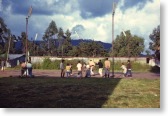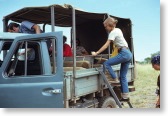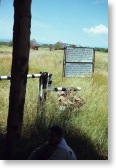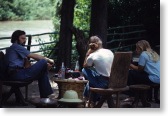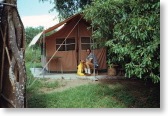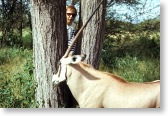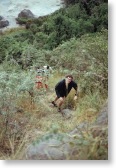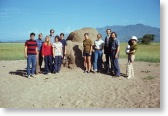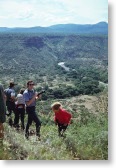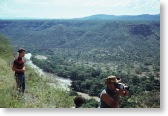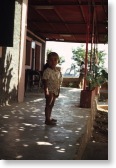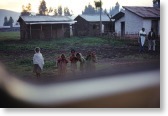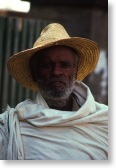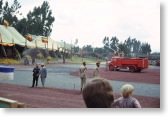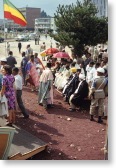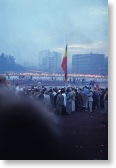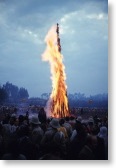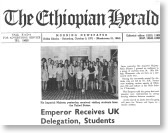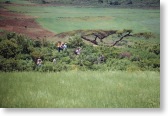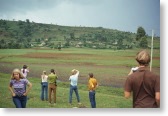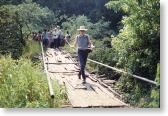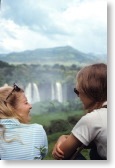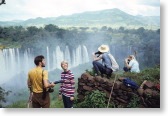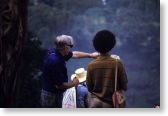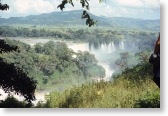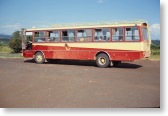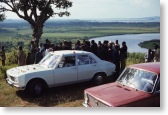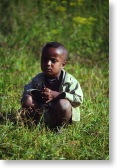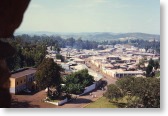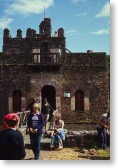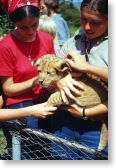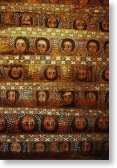The 1971-72 Global
Semester, Day by Day
Wednesday, September 8, 1971
We had breakfast on the plane. It was weird:
cream cheese, tomatoes, rolls, preserves, orange juice and
tea. We slept about 2 hours. We were really beat when we
got to the YMCA in Addis Ababa. Arrived at the YMCA about 11:45 AM. The
living conditions here will take some getting used to. We
are no longer in Europe.
The place is nice. It has large clean rooms with a bath.
The whole place is pretty new I
think. We have a door leading out into the yard outside.
The weather here now is very damp and cool. We have been
freezing since we came here. The air smells musty and
smoky. We ate a large lunch here for $1.40 for both of us.
It was a huge bowl of thick soup with peas in it, then a
squash stuffed with rice and tomato, then potatoes, fried
fish, and tomatoes and lettuce with a banana for dessert.
We slept a couple of hours this afternoon before our
orientation meeting.
We learned that "alfundigoom" (phonetic)
means I don't want and "yellum" means no. Our classes at
Haile Selassie University will be in the Arts Building,
Room 118.
Thursday, September 9, 1971
We had our first lectures: church history in
Ethiopia.
Friday, September 10, 1971
Two boring lectures from Alula on Ethiopian geography and
topography.
Everyone gets so tired out just walking to the university
twice a day that we don’t have energy to do anything else.
For lunch we eat bread, peanut butter and fruit. A loaf of
bread is 10¢. The peanut butter was expensive, about $1.00.
Oranges are 10¢ each so we can get by on about 15¢ a day.
We could get a huge meal at the restaurant for 90¢.
We were told by the YMCA director that it isn’t safe on the
streets and that we shouldn’t trust anyone. He himself
carries a gun. There are armed guards with rifles around
here at night.
Saturday, September 11, 1971
Alula took us around Haile
Selassie University. In the afternoon we did nothing but
play a little lawn hockey.
Sunday, September 12, 1971
Last night was New Year’s Eve here according to the
Ethiopian calendar. The YMCA is only about 50 yards from
the largest church in Ethiopia. At 1:00 AM we were awakened
by church bells. First there was ding ding ding and then an
answering BONG BONG BONG which really rattled the windows.
At 2:00 the mass started. It was all sung, sort of a
Gregorian chant, with a definite African rhythm and style.
It sounded like several thousand people singing just
outside the door. There were some long solos by a man (a
priest, I assume), accompanied by a drum and/or answered by
a chorus from the congregation. It was eerie and beautiful
but became tiresome after five hours. Every so often they
would stop for a few minutes and those awful bells would
ring again. This might have signaled the beginning of
another service. Then, at sunrise, they fired a cannon
about a dozen times and I thought our glass door was going
to break.
Yesterday we went to the University library and the
Ethiopian Institute. The library is very new and impressive
looking. It is called the John F. Kennedy Memorial Library.
I heard part of Narums’ tape of Amharic phrases today. It’s
a difficult language but I’m going to make a real effort to
learn some of it.
From our door, where I’m sitting, can be seen, in front,
our narrow yard with its hacked-up grass (from field
hockey), an 8 ft rusted fence covered by vines and
following it a line of eucalyptus trees, another yard
behind that with long grass, a row of bushes and trees, and
the dome and steeple of the church. On the left is a hedge,
a basketball court, a couple corrugated metal sheds, and
forested hills behind. On the right is a cement wall topped
with corrugated metal, a narrow and muddy street or alley
(out of view) and a dorm for the Lutheran school next door.
It is white cement with a corrugated roof.
We walked down that alley this
afternoon to the church. It is surrounded by a stone wall
and groves of trees, most of which are unfamiliar to me.
There are also several small cemeteries with large and
fancy tombstones and statues and several monuments by
themselves. The church itself is huge and has both a dome
and a steeple.
Monday, September 13, 1971
We had two more lectures from
Alula: one on the climate, peoples, and agriculture of
Ethiopia and one on history concentrating on the Aksumite
culture.
Today we walked to the Belvedere
Gallery.
Tuesday, September 14, 1971
We had our first
lecture by Narum today. Ways of thinking <> ideals of
life (values) <> philosophy.
Two more lectures
on Ethiopian history: Zagwe kings and Lasta regime to the
16th century.
Wednesday, September 15, 1971
The last history lecture from
Merid.
Thursday, September 16, 1971
Our lectures up until today have not been worth much.
Today, however, our prof (Negussay) knew what he was
talking about, was organized, concise, and spoke perfect
English – and also said something worth saying. The others
have sort of babbled on and on and haven’t really said
anything. Negussay's lecture
was on Ethiopian government.
We had our first discussion group on Narum's course.
(Chapter 1 of Smart.)
The weather is still cool and rainy.
The water just never gets hot here.
Friday, September 17, 1971
Two lectures from Getachew:
one on traditional Ethiopian education and one on Ge'ez
literature.
Saturday, September 18, 1971
After much confusion and hesitation, we and ten others
decided to go on a camera safari at Camp Awash in the
national park in the Awash Valley.
We got up at 4:30 AM Saturday morning and got a taxi at
5:00 to the bus depot. It was dark and rainy and not like
any bus depot I’ve seen. It consisted of a couple of sheds
and a row of buses and a crowd of people with odd
assortments of packages. We had been told that we could buy
tickets on the bus so we asked which bus went to Awash and
climbed on. After we had sat there awhile someone got on
and told us we had to buy tickets at the ticket counter so
Dirk and Jeff got off, bought our tickets and came back
with them. We were all sitting in the front and the tickets
assigned to us were in the back. Apparently we had been
sitting in other people’s places because there was some
confusion among the other passengers which, of course, we
didn’t understand. After all the confusion had died down, a
man from the depot got on and informed us we were on the
wrong bus. So then we moved and discovered the same
confusion in the other bus. In this bus the seats were
numbered in a strange way with numbers missing that had
been assigned to one of our group. We finally got settled
in a triple seat with an Arab man. We finally got rolling
at 6:45 AM, only 15 minutes late. We had gotten conflicting
reports about how long the bus to Awash would take. The
travel agency insisted 5-1/2 hours, the local people said
10 hours, and the bus depot said 7 hours. It took us 3-1/4
hours, much to our relief. It’s 200 km (125 miles).
We arrived in Metehara at 10:00 and, after fighting our way
off the bus, we were met by Ted Shappo, the man who would
take us on our safari. He was a stocky, middle-aged
American (California) with a crew cut, bow legs, and a dark
tan. He looked like John Steinbeck. He led us to a Land
Rover with 12 seats in the back and off we went.
The vegetation here is
“tropical forest and thornbush” not “jungle.”
The camp is right on the river,
which flows fast and muddy now during the rainy season. Ted
owns the camp with his German wife Barbara (very young) and
has black helpers and a black manager named Ato Mohammed.
Ted and Barbara have adopted the most beautiful little
black girl, about 4 years old. Ato’s son is about 2 or 3
and he’s darling.
The tents we sleep in are very
nice, similar to our American tents: mosquito proof,
plastic floor. They had cots in them, a chair, a table, and
jimma stools outside carved from a single piece of wood.
The tent is on a slab of cement. All the tents were right
on the river bank. A shower (3 bamboo sides and an oil drum
with a shower head) faces the river. The latrine is a mud
hut with a thatched roof, wood floor, with a square hole in
the middle. There are a few crocodiles (14 feet long) and a
hippo nearby which we heard but never saw.
The camp is very small. The 12
of us just about filled it up. It was nice to be warm
again. It’s hot in the sun but nice in the shade. We’re a
lot lower in altitude here too: only 1000 feet above sea
level. The air is clean here too, not musty and damp and
smoky like Addis.
Sunday, September 19, 1971
After a huge breakfast at 7:00 we were off on our camera
safari in the Russian land rover. Marylou got heatstroke
the day before so couldn’t come on the safari.
We left the camp in time to get
to Metehara a half hour before the train was supposed to
leave at 2:11. The 2nd class was filled so we had to decide
whether to take 1st or 3rd class. Most took 3rd but there
was a huge crowd waiting for the train and obviously not
for 1st class. Also, the 3rd class has just hardwood
benches and it was a 4 hour ride with no guarantee of any
seat at all. So four of us took 1st class. It was only
$7.20 a piece but, of course, 3rd class was only $2.
Marylou took 1st because she was sick. Carl, a student
staying at the Y in Addis also took 1st and we did too. We
were glad we did. The train had 3 cars on it, one for each
class. First class was nice – comfortable seats and more
leg room than I’ve ever seen. There were only 14 seats in
the whole car. We had a pleasant ride while the others
really had an experience. We all arrived safely
though and got a taxi back to the Y in time for supper.
Monday, September 20, 1971
Getachew lectured on Amharic
literature.
Tuesday, September 21, 1971
We had our second
Narum lecture.
The Ethiopian
lecture today was on family relationships: inheritance,
marriage, socialization of children, family services
associations, etc.
Wednesday, September 22, 1971
Today's lecture was on cottage
industries in Ethiopia.
We went to the Radio Voice of the Gospel headquarters.
Afterwards we went to a seminary mission run by some
missionaries where we slaved for a few hours weeding,
cultivating, and painting. After that we went to Rev.
Everson’s house where we were overwhelmed: a real house,
warm, American, cozy, with comfortable furniture and, best
of all, lemonade, potato salad, beans, cookies, and cake!
Thursday, September 23, 1971
Narum discussion group today.
Ontology.
We went to the main post
office and discovered it too follows the siesta schedule
we’ve found in all of the other countries up to now: closed
from 1 to 3. Today's lecture was on economic development,
particularly on how Ethiopian cultural values devalue work
and hinder economic development.
Friday, September 24, 1971
Mesfin gave an impassioned
lecture today on development, education, and land
reform.
Saturday, September 25, 1971
We tried to take some pictures
of the street boys. Since, ordinarily, Ethiopians don’t
like their pictures taken, we thought we’d try to buy some
pictures by paying 10¢ to 25¢ Ethiopian. No go. When we
asked one little boy, by the time he could figure out what
we were saying some older boys had gathered and were trying
to prevent it, probably because they weren’t getting a
share. We left and found an old man dressed in khaki rags
and a white blanket (common dress in Addis). He apparently
wanted a cigarette and when I showed him I had none he
consented to have his picture taken, primping himself up
while I got him in focus.
Meanwhile, a crowd had gathered again. The
old man apparently thought I had a Polaroid and could give
him a picture. I told him I couldn’t but offered him a
quarter. He shook his head and moved away. Some people
asked me why I took his picture. When I replied that he was
interesting they seemed surprised.
Sunday, September 26,
1971
Monday, September 27, 1971
Today was Meskal – celebrating the finding of the true
cross by St. Helena. The combination of wailing, brightly
clothed and umbrella’d priests, the American ambassador’s
wife in furs and movie camera, planes in cross formation,
and helicopters with neon crosses was nearly too much. The
floats in the parade were horrendous: boxlike, painted in
Ethiopian style, with flashing neon crosses. Before the
ceremony started there was a cloudburst. I was glad we were
under a roof! The guards put on their raincoats and then
stood and laughed at everyone. Ethiopian people tried to
crawl under the stand we were on for cover and they were
dragged out by the guards who beat on them with sticks and
laughed.
Following the end of the parade was the
1-1/2 to 2 mile trek home. Virtually all of Addis was out
there and they were all walking home too, filling the
streets and making auto traffic honk and screech. It was
shoulder-to-shoulder nearly all the way and we sure were
glad to get back to the Y.
Tuesday, September 28, 1971
We had our third Narum lecture
today.
Wednesday, September 29, 1971
Thursday, September 30, 1971
Friday, October 1, 1971
Today we had an audience with the emperor. (Jeff Jerde was able to recite Haile
Selassie’s full title: "His Imperial Majesty Haile Selassie
I, Conquering Lion of the Tribe of Judah, King of Kings of
Ethiopia and Elect of God.”) We all got dressed up
in our best clothes (we were amazed at how good we all
looked). Then we marched en masse down to the palace at
10:00. It isn’t very far: it only took us 15 minutes. The
guards at the gate panicked when they saw us coming. We
waited at the gate and they finally let us in and told us
to go to the waiting room. We walked up a road lined with
gardens and guards and up a hill to the palace complex
where the government offices are now. (The emperor lives at
a new palace called the Jubilee Palace.) There were lion
cages there and four lions, one lying on a cement slab
right out in the open with no cage! The others were tame,
too, I’m sure, but they could reach through the bars so we
didn’t get too close. Our appointment was postponed until
11:00 so we had a lot of time to look around. The emperor
has 3 tiny Mexican chihuahuas. They were scampering around
and barking ferociously at people.
At 11:00 we were motioned into the offices, first through
one outer office then through one with gild and beautiful
carpeting and paintings and then into His Majesty’s office.
There he stood, in front of his huge carved wooden desk in
a beautiful room with gorgeous oriental carpeting and
paintings and a fireplace. He looked very small and timid.
He’s about 5’ 2” at the most and he wears a military
uniform with many medals and baggy pants. The Narums
introduced us one by one and we shook his hand and smiled
(what do you say to an emperor?). Then we lined up along
the sides and Dr. Narum gave a speech about our purpose and
our visit, etc., and presented
the emperor with some pictures. Then Haile gave a
speech in Amharic and his aide translated it. It was the
usual stuff about foreign studies furthering the cause of
peace and understanding, etc. Selassie said that he appreciated that
American students could come here to visit and study in his
country just as Ethiopian students could study in America.
He also reminded us of his, and Nixon’s, impending trips to
China. I wonder if he understood all that Narum said
– he looked sort of blank some of the time. But then his
speech was very similar to Narum’s. (Dr. Narum said that we sought “not
cultural uniformity with political differences but
political peace and harmony amidst cultural variation,” – a
paraphrase but close.) All this time his little dogs
were running all over the room. It occurred to me that
maybe the reason he has such tiny dogs is that they make
him look bigger.
He talked to Paul Narum and
took his hand and walked out into the other room. We
followed and they took a group picture of us with the
emperor.
Then we shook his hand again
and thanked him and left. It was all sort of like a dream.
We were all sort of nervous and it was a relief to get it
over with.
The weather has really improved since Meskal. It hasn’t
rained and it’s much drier and warmer. The air isn’t as
smoky either.
Saturday, October 2, 1971
We were up and at breakfast at 5:15. They gave us porridge
but neglected to tell us that there was no milk. So we gave
it back and ordered eggs.
The 12 hour trip to Bahir Dar was awful.
The roads are very winding and
narrow and there are animals all over the roads. The bus
driver is constantly honking his horn long and loud. The
paved road ran out at about half way and the rest of the
way was dusty and the road was even narrower.
The hotel in Bahir Dar was beautiful: very clean with
wonderful mattresses and hot water. The Blue Nile Springs
Hotel was like a motel – several long low buildings with
porches and chairs outside, covered with flowering vines
and surrounded by gardens of Bird-of-Paradise trees and
poinsettias.
Sunday, October 3, 1971
We went to the Blue Nile Falls just a ways outside of town.
We hiked to the falls, a half-hour walk, surrounded by
guards and little boys. A kid named Amelek gave me a stick
and told me about the area. He was very nice and didn’t ask
for money. On the way back, however, he hinted that he was
very poor and he needed an English book. Of course, I
didn’t have an English book. I gave him some cookies and a
quarter (that was all I had). He gave me a rock with some
green ore in it and carried my purse. When we got back to
the bus a cop chased all the kids away and kicked one of
them – the one who had carried Don’s jacket. He was deaf
too I think. He cried and cried and we felt so sorry for
him we gave him some money too.
The falls were magnificent. We didn’t dare walk around much
because of the snakes in the area. The bridge we had to
cross over part of the river was very rickety – just
planks. Later we found out it was 40 meters deep there
because of the rapids.
When we got back to the bus the
bus driver was gone and the doors locked so Doug, with a
boost from Don, crawled in the window and opened the door.
We were all dying of thirst
when we got back to the hotel. Ethiopian beer is milder
than American beer and not as bitter. It sure did away with
my thirst.
In the afternoon we went to see one of the emperor’s
palaces – a new one – but we couldn’t get in. We drove to a
hill overlooking Lake Tana and unwittingly crashed an
engagement party there. Young, well-dressed men were
clapping and singing and jumping around. They gave us food
and asked us about our trip. They recognized us from the
picture of our group with Emperor Selassie that had been
published in the newspaper.
From there we went to Lake Tana
where a man offered to show us a village “5 minutes away”
where they made baskets. Of course it took 15 minutes and
when we got there it turned out to be a few fly-infested
hovels with dirty children running all over. When the women
saw us coming they ran and got their baskets. All of them
wanted money. We felt like we were mobbed and suffocated
and contaminated by the flies. Then the bus came and we
left, gladly.
Monday, October 4, 1971
We went to Gondar. The main buildings in this town are very
Italian in style, stucco with shutters.
The streets are paved but it is
an awfully quiet town for having 30,000 people. The taxis
are horse-drawn things that look like boat trailers. The
flies are horrendous! They swarm all over and especially
like to fly into your mouth.
We saw King Fasil’s swimming pool in the afternoon. It had
beautiful flowers growing around it and Meskal flowers and
marigolds growing inside.
Our room was pretty crummy:
crowded and not real clean. The bathroom really smelled bad
and there wasn’t a waste basket in the whole hotel. We had
spaghetti for supper which was OK. Some had injara and wot.
I tasted some and thought my mouth, throat, and lips were
going to burn right off. It got worse as the minutes
passed.
After dinner we had a good time singing. Mrs. Narum
directed rounds, “The Three Blind Mice are Dead,” “Abraham
Brown is Dead and Gone,” etc.
Tuesday, October 5, 1971
We saw some old Portuguese castles which didn’t impress me
too much.
Then we hiked up a rocky road
to Debra Birham Selassie Church. We had a letter from the
governor saying we could get in free but the wild-eyed
priest at the gate wouldn’t believe it. We were willing to
pay the $1 each to get in since we didn’t want to walk all
that way for nothing but the guide and the cop with us got
mad and insisted on going back to the governor to get his
seal put on it. So we all sat on the steps for an hour with
flies sitting all over us. The church did have some
beautiful paintings in it although many were beginning to
rot away. For being “the” church in the area it sure was
poor. It had 17th century Portuguese brick, now roofed with
corrugated metal, and was very tiny with mat floors and no
lights or windows.
We were very glad to leave
Gondar.
Back at Bahir Dar, they were short of rooms so they gave us
the manager’s room which was OK but was not as clean as the
other one we had. And it had no wastebasket!
Wednesday, October 6, 1971
The ride back to Addis wasn’t as bad as the ride to Bahir
Dar. The Blue Nile gorge was beautiful. Our first glimpse
of it was at 2500 meters above sea level (the bus had an
altimeter).
The bottom of the gorge is 1000
meters so it’s really a drop – deeper than the Grand
Canyon. The river is actually very narrow at the bottom but
the canyon is very wide.
The rest of the countryside was
pretty monotonous: hills covered with grass, some trees,
tukals, animals, and flowers. With ugly, dirty villages
here and there.
Thursday, October 7, 1971
Today we had tea at the American embassy. We took buses and
taxis up there at 5:00. The embassy compound is very large
and beautiful with gardens, nice lawns, huge trees, and
many buildings. We walked up the red-carpeted stairs to the
mansion and were greeted at the door by the ambassador, E.
Ross Adair, and his wife. They showed us around the
mansion’s main floor sitting rooms, which were beautiful
with white walls, paintings, and colonial furniture. They
had pictures of themselves with the Johnsons and the Nixons
and autographed pictures of Nixon and Agnew. Then we had
tea and cookies (which were delicious, chocolate chip
even!) on official
china and the ambassador told us about American
involvement in Ethiopia. There are about 6,000 Americans in
the country right now, not including missionaries. The U.S.
has put quite a bit of money into this country. I wasn’t
really surprised to hear that that nice library at the
university was built with American funds and that 50 of the
professors are Americans whose salaries are paid by the
United States. (Most of the
Ambassador’s claims were discounted by Professor
Mesfin.)
We all made real pigs of ourselves and ate all of the
cookies. The Adairs were very nice and encouraged us to eat
them. He sort of reminds me of John McGiver, the comedian.
He was a congressman from Indiana for 20 years before
becoming the ambassador 3 months ago. He’s a real
politician and a Republican, of course.
They showed us their new glass-walled tukal that is built
with a huge tree in the middle of it. It was really pretty
as was their yard and gardens, which Mrs. Adair had been
working on.
On the window sill in one of the back windows, I saw three
wig stands, two of them with platinum blond wigs on them
just like Mrs. Adair’s hair. I wonder what she needs three
identical wigs for.
Mr. Adair said that there were 100 U.S. embassies around
the world. I asked him if he thought there would be an
embassy in mainland China soon and he said probably but
that he liked and felt sympathy for Taiwan, knew Chiang
Kai-shek, etc., so he hoped Taiwan wouldn’t get pushed out
of the U.N. He said that the President had instructed all
of the ambassadors to talk to other ambassadors and heads
of state to get support for Taiwan and he had been doing
this.
Mrs. Adair told us that when “kids” came to the embassy
they had hamburgers, potato chips, and cokes.
Unfortunately, I guess, they didn’t think we were kids!
We left invigorated from our
second important social event of the week. We also left a
little prouder of our country.
Friday, October 8, 1971
Mary and I and Marylou had
cheeseburgers and Cokes at the Poste Rendezvous, an
American-European type of restaurant in front of the main
post office.
We had a seminar today from Mesfin on foreign aid, its
dubious results and its adverse effects.
Saturday, October 9, 1971
We had a farewell party tonight. The Y’s restaurant really went all out in
serving us a big buffet supper in the library. We sang and
enjoyed ourselves. An Ethiopian who graduated from St. Olaf
in 1960 was there (“I am a brown Norwegian”) as was
Zeruhin, an up-and-coming Ethiopian
artist.
Professor Mesfin said that whenever we hear about Ethiopia
from now on we won’t just think of it as a place on the map
but as a real place where there are familiar faces and
friends. He also said that he hoped we would take some of
their pain and troubles with us, their problems and hopes
becoming partly ours also.
Sunday, October 10, 1971

